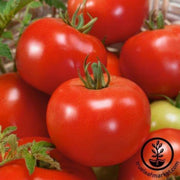Out Of Stock!
We will notify you when this product becomes available.
Tomato Seeds - Slicing - Red Russian
70-80 Days to maturity (from transplant). Solanum lycopersicum. Red Russian Tomato Seeds. Non-GMO, warm season annual, open-pollinated, heirloom, indeterminate, slicing tomato. Suitable for growing in garden plots, raised beds, and greenhouses. A red, medium-sized red globe tomato that tolerates low temperatures. ~6,800 seeds/oz.




Download Free Vegetable Growing Guide PDF
Growing Red Russian Tomatoes in the Vegetable Garden
Growing tomatoes from seed is an exciting and rewarding venture for beginners. Start by choosing high-quality tomato seeds from a reliable source. To nurture these seeds into healthy plants, use a well-draining seed starting mix consisting of organic potting soil, coconut coir, and perlite. Plant the seeds about a quarter inch deep in individual containers, ensuring they are evenly spaced. Keep the soil consistently moist but not waterlogged to facilitate germination. Provide adequate light for your tomato seeds. If natural sunlight is limited, consider using a grow light to ensure they receive sufficient light for optimal growth. As the seedlings develop true leaves and reach a height of 6-8 inches, it's time to transplant them into larger containers or directly into the garden.
When choosing a garden location, opt for a sunny spot with well-draining soil enriched with compost. Tomatoes thrive in sunlight, so ensure they receive at least 6-8 hours of sunlight daily. Before transplanting, it's crucial to harden off the seedlings gradually. Introduce them to outdoor conditions by placing them outside for a few hours each day, gradually increasing the duration over a week. This acclimatization process prepares the seedlings for the transition to the garden, reducing the risk of transplant shock. Transplant the seedlings carefully, making sure to bury the stem, including the lower set of leaves, into the soil. This encourages maximum root development and stability. Water the transplants thoroughly and consider adding a handful of well-aged compost or worm castings to the planting hole for added nutrients.
As your tomato plants grow, provide support with stakes or cages to prevent sprawling. Pruning may be necessary to manage their vigorous growth, ensuring adequate airflow and focusing energy on fruit production. Water consistently, preferably at the base of the plants, using a soaker hose or drip irrigation system to minimize the risk of fungal diseases. By following these steps, even those with minimal gardening knowledge can successfully grow tomatoes from seed, enjoying the satisfaction of nurturing plants from their earliest stages to a bountiful harvest.
Harvesting Red Russian Tomatoes
Harvesting tomatoes is a rewarding culmination of your gardening efforts. Begin by observing the tomatoes for vibrant color, firmness, and a slight give when gently squeezed. Use sharp scissors or pruning shears to avoid damaging the plant. It's essential to harvest regularly, promoting continuous fruit production. Check the plants for any signs of pests or diseases during harvesting, inspecting leaves, stems, and fruits. This proactive approach helps maintain a healthy garden. Once harvested, store tomatoes at room temperature to ripen fully. If already ripe and not immediately consumed, refrigeration slows down the ripening process, extending freshness. These simple steps ensure novice gardeners enjoy the full benefits of their homegrown tomatoes.
About Red Russian Tomato Garden Seeds
The Red Russian tomato likely got its name due to its association with Russian heritage and its distinct red color when ripe. Naming conventions for tomatoes often reflect their origin, characteristics, or the variety's heritage. In this case, "Red Russian" suggests a red-hued tomato with a connection to Russian culinary traditions or breeding history.
Cultivated tomatoes (Solanum lycopersicum) originated in western South America, specifically in the region of present-day Ecuador, Peru, Bolivia, and northern Chile. Native peoples in this area were the first to cultivate and domesticate tomatoes. The crop eventually spread globally, becoming a staple in various cuisines and a versatile ingredient in countless dishes.
These medium-tall upright bushes have thick, heavy leaves and foliage perfect for shading these delicious fruits. The medium-sized red globes tolerate low temperatures fairly well. This variety was imported from New Zealand and is quite popular there.
There are many ways to fertilize tomatoes, but the general recommendations are as follows: Properly fertilizing tomatoes involves applying a balanced, organic fertilizer rich in essential nutrients. Begin with well-aged compost or worm castings at planting, ensuring optimal soil fertility. Use a tomato-specific organic fertilizer during the growing season, following package instructions for application rates. Regular feeding supports robust growth and enhances fruit development.
Heirloom tomatoes shine in various popular recipes. Caprese Salad, a classic, combines tomatoes, fresh mozzarella, basil, and balsamic glaze. Heirloom Tomato Bruschetta features diced tomatoes, garlic, and basil on toasted bread. A refreshing Heirloom Tomato Gazpacho blends tomatoes, peppers, cucumbers, onions, and herbs. Heirloom Tomato Salsa, with diced tomatoes, onions, cilantro, and lime juice, and adds zest to any dish. Lastly, a savory Heirloom Tomato Tart layers sliced tomatoes on puff pastry with cheese and herbs, creating a delightful and flavorful treat.
Tips From Our Gardeners
"Tomatoes are an underrated fruit. The acidity can be off-putting to those with surface-level experience but the subtle differences from variety to variety is exciting to those who know. Perhaps those who claim to not like tomatoes are just those who haven’t found their preferred variety!"
 |
- Lara Wadsworth, True Leaf Market Writer |
Other Resources
Red Russian Tomato Seeds Per Package:
- 300 mg packet - Approximately 65 Seeds
- .25 oz - Approximately 1,700 Seeds
- 1 oz - Approximately 6,800 Seeds
- 4 oz - Approximately 27,200 Seeds
- 1 lb - Approximately 108,800 Seeds
Non-GMO Red Russian Tomato seeds are available for Fast Free Shipping on qualifying orders.
Basic Info
| Latin Name: | Solanum lycoperscium (previously Lycopersicon esculentum) |
| Tomato Type: | Slicing - Larger, round tomatoes, the size of your fist or larger. |
| Red Russian Tomato Color: | Red |
| Red Russian Tomato Flavor: | Mild, tangy |
Growing Info
| Hardiness Zone: | 2, 3, 4, 5, 6, 7, 8, 9, 10, 11 Annual: Not intended to overwinter |
| Days to Maturity: | 70-80 (from transplant) |
| Days to Germination: | 7-10 |
| Seeding Depth: | 0.25 inch |
| Plant Spacing: | 24-36 inches |
| Row Spacing: | 36 inches |
| Plant Height: | 48-60 inches |
| Growth Habit: | Indeterminate - Indeterminate tomatoes are vine-type plants that sprawl (requiring a cage or trellis to support them) and continue to grow throughout the season. Indeterminate tomato plants will continue to produce tomatoes for the rest of the season, so you can harvest continually. |
| Soil Preference: | Well-draining, loose (sandy loam), slightly acidic (6.2 to 6.8), and moisture retaining. Too much nitrogen in the soil may lead to more foliage production and less fruiting. Tomatoes like more phosphorus and potassium than other vegetables. |
| Temperature Preference: | Warmer (70-85 F) |
| Light Preference: | Full Sun |
Other
| Direct Sow: | No |
| Start Indoors: | Yes. Start Indoors 7-9 weeks before your last spring frost date. |
| Plant Width: | 24 inches |
| Plant Spread: | 24 inches |
| Growth Speed: | Mid - Ready to harvest 70 to 80 days from transplant. Tricky to get a tomato by the 4th of July with these varieties. They are good mid-summer producers for most USDA Zones. |
| Germination Temperature: | 65-85 F |
| Pests and Diseases: | Common pests known to harm tomato plants, in general, include the tomato hornworm, cutworm, aphids, flea beetles, tomato fruit worms, and whiteflies. Also, watch for common diseases such as blossom end rot, fusarium wilt, powdery mildew, verticillium wilt, late blight, bacterial canker/spot, and tobacco mosaic virus. Most of these can be prevented by maintaining a regular watering schedule and avoiding overwatering. Regularly check your plants for pest damage throughout the season. For treating pest and disease problems, we recommend using an organic neem-based product. |
| Garden Size: | Greenhouse, Garden Plot, Raised Bed |
| Tomato Use: | Salads, fresh eating, |















